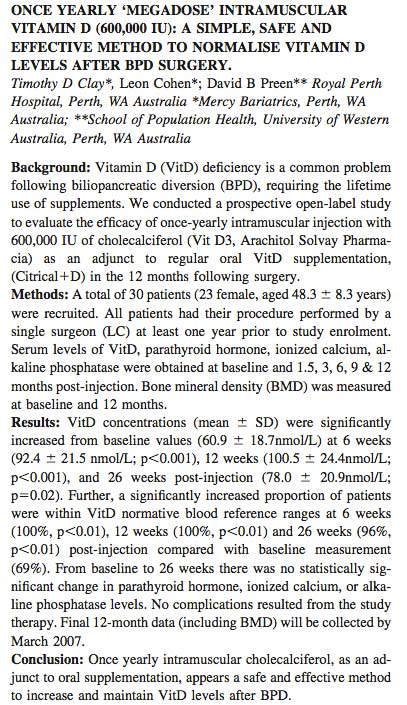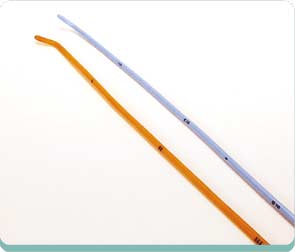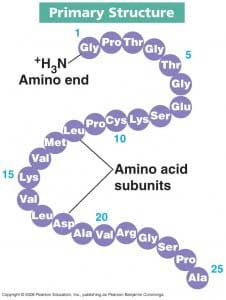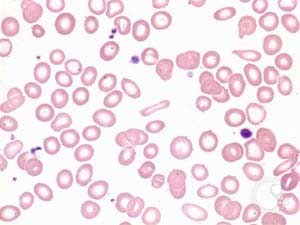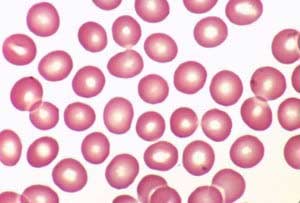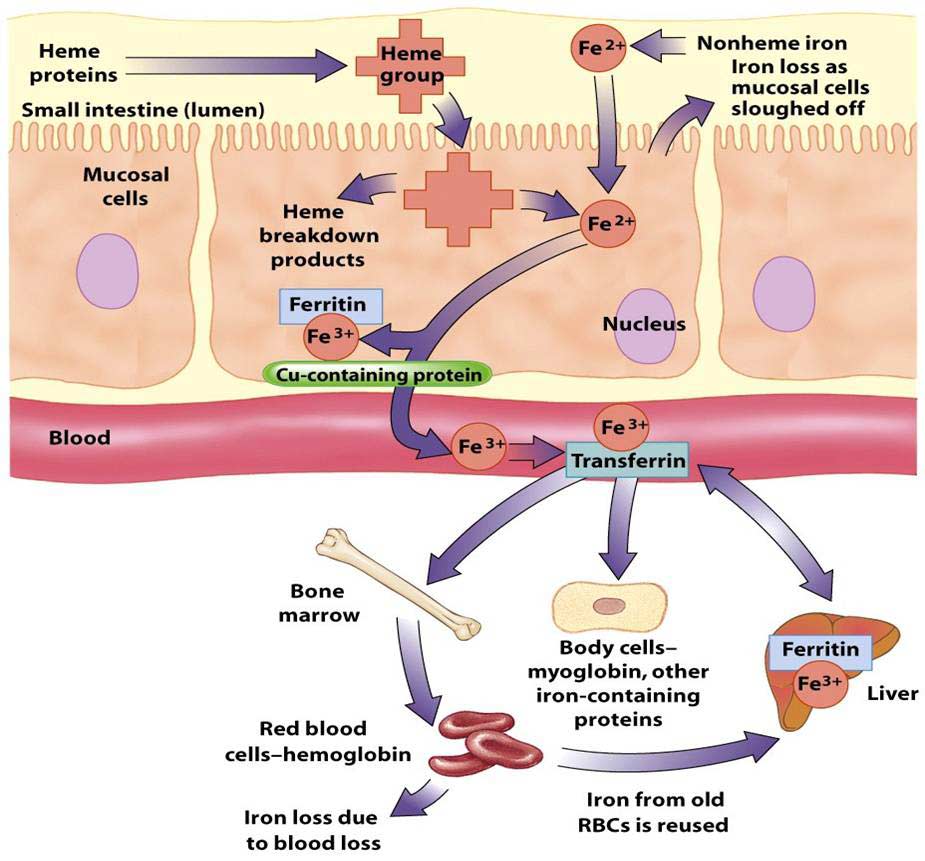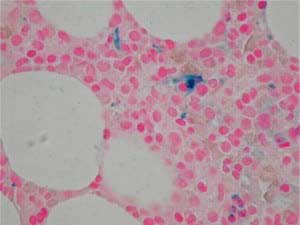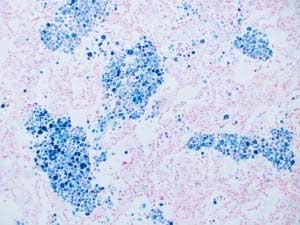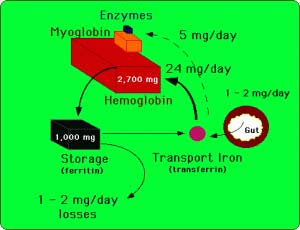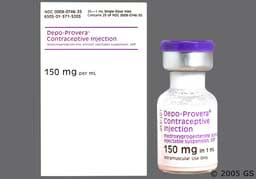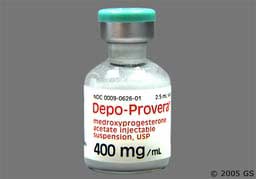Category: Weight Loss Surgery
Injectable Vitamin D Information and Research Articles
July 11, 2014 1:06 am
Injectable Vitamin D may be needed in some cases of Vitamin D deficiency or inability to increase Vitamin D level with oral supplements. Vitamin D is a fat soluble vitamin. It plays an important role in bone metabolism and structure. It has also been found to affect the immune regulation, control off- inflammatory reactions, and also be involved in a number of broad cellular functions throughout the body. Until a few years ago, very little attention was given to vitamin D levels. More recently, we have realized that due to a number of factors, there is a tendency for vitamin D deficiency to be present in the U.S. adult population. This finding is even more pronounced and severe in overweight patients.
The recommended dose for vitamin D supplements is much larger today than it was a few years ago. For example, it is not too uncommon to recommend an average dose of a 50,000 (IU) international unit of vitamin D by mouth on a daily basis after the duodenal switch operation.
Since vitamin D is a fat soluble vitamin, it is important that the appropriate type be utilized. Dry formulation of vitamin D is needed to ensure adequate absorption. There are a number of manufacturers that produce these. When searching for Dry Vitamin D the type a patient should be looking for is “Dry” D3-50. Some larger supplement manufacturer’s carry these products. The links to these manufacturers is located here. The “Dry” type of Vitamin D should NOT be taken with fatty or oily foods. Also to optimizes absorption they should be taken either 30 minutes prior to eating food or 30 minutes after eating.
If you are deficient in Vitamin D after trying “Dry” or water miscible Vitamin D then intramuscular Vitamin D injections might be an effective way to normalize your Vitamin D levels. Vitamin D can be formulated and purchased from any compounding pharmacies that are equipped and experienced in the interpretation of injectable vitamins and minerals. Your primary care WILL need to contact the compounding pharmacy of their choose for the recommendations and be willing to make the injections available to you. UNLESS you have been told to stop taking your daily “Dry” Vitamin D tablet supplement you should continue taking it after the injection.
We are supplying the following so that your PCP will understand the research behind injectable Vitamin D and to hopefully ensure that every patient is armed with this knowledge. Vitamin D deficiencies are becoming more common place in society due to the use of sunscreen and sun shielding clothing and hats, not only Duodenal Switch patients.
This is a research paper out of Finland that discusses injectable Vitamin D for the aged. The information can translate to anyone who finds themselves in a Vitamin D deficit state. https://www.gwern.net/docs/nootropics/1992-heikinheimo.pdf
This research paper is out of Australia where despite then sun drenched climate they are experiencing a large amount of people with Vitamin D deficiencies due to sunscreen, veiling, malabsorption, etc.
https://www.direct-ms.org/pdf/VitDGenScience/Vit%20D%20deficiency%20Australia%20art%20and%20ed.pdf
Below find the order sheet with the Injectable Vitamin D concentration listed. The common dosing for the vitamin D is 600,000 IU, deep IM every 6 months till the levels are normalized. The patient then can take the oral supplements only.
Finally, this is an except from an another Australian research paper describing the use of Megadoses of injectable Vitamin D in patients after Biliopancreatic Diversion which has a malabsorptive component similar to Duodenal Switch.
What size is my Bougie?
July 10, 2014 6:57 pm
A Bougie is a flexible plastic tube that comes in different sizes. It can be used to calibrate the size of the stomach during the duodenal switch or Sleeve gastrectomy. It is also used to dilate strictures of the esophagus or the stomach.
I am commonly asked what size is the bougie that I use. My usual answer is that it is equivalent to a 38 or so, and that the size does not matter.
Many surgeons do not use these types dilators, but rather alternative tubes that function as a sizer and a suction tube to eliminates the need for multiple tube insertions and removals.
The July 2014 publication of Obesity Surgery had and article by Spivak et.al. titled “Laparsocopic Sleeve Gastrectomy Using 42-French Versus 32-French Bougie: The First-Year Outcome.” In conclusion they reported that using 42 vs 32 French Bougie does not influence the weight loss of resolution of the combed condition in the first year.
There also other studies that support the position of erring on the side a larger sizer, a 40-French, to decrease the leak rate without having an impact on the excess weight loss at 3 years time.
The take home massage is that the size of the stomach after the sleeve does not predict the outcome of the weight loss surgery independently. There are multiple factors in play such as age, amount of excess weight, diet adherence and exercise.
Single-Anastomosis DuodenoIleal Bypass (SADI)
June 23, 2014 6:30 pm
Single anastomosis duodenal switch, also known as Single Anastomosis DuodenoIleal Bypass (SADI) is a procedure that is being discussed in literature. There have been a few series of case reports that have been published in the last few years. I would like to review the procedure and share my opinion.
The theory behind the SADI has been to simplify the duodenal switch procedure. In “classical” duodenal switch procedure, the small bowel is divided in two places, (duodenum, and distal ileum) and two anastomosis are created (duodeno-ileostomy, and ileo-lieostomy). This can theoretically provide two potential places for leak, bleeding, adhesions as complications. In SADI, there is a single bowel division of the duodenum and a single anastimosis of the duodenum and the ileum. The sleeve component of the procedure is the same for both procedures. This is where their similarities end.
In the duodenal switch operation, the bowel is partitioned in to two parallel limbs- one that carries the biliopancreatic juices and a parallel limb that bring the food down from the post pyloric duodenum. They then join and form the common channel. The length of the biliopancreatic limb is so long that it does not allow bile to reflux back into the duodenum or back to the stomach causing the complication of bile reflux gastritis. With the single anastomosis of the SADI, the length of the bowel where the bile meets the duodenum is shorter than it is in normal anatomy. This significantly increases the possibility of the bile reflux. The second difference is the selective nature of the reduced absorption of the fat in the duodenal switch, in comparison to that of the carbohydrates. Duodenal switch operation has two absorptive lengths- the Alimentary channel, which is involved with protein and carbohydrate absorption, and the common channel that absorbs, fat, protein and carbohydrates. One can make changes to the common channel and impact the fat absorption significantly more than that of the carbohydrate and the proteins. In SADI procedure, that common channel and the alimentary limb are both the same- there is no way to selectively adjust the fat absorption without making significant changes to that of the protein and carbohydrate absorption.
There are a number of publications that have reported the short-term outcome of the SADI procedure. They appear promising, but they are short-term results. Long-term data is needed. If the outcome does not change significantly over time, then I could see a role for SADI in the treatment for obesity. In the mean time, patients need to be made aware that the suggestion that SADI is the same as the duodenal switch is probably not correct since we do not have the data to support this oversimplification.
Shared Success Story: Cyndi E. Had a Gastric Bypass to Duodenal Switch Revision
June 17, 2014 6:29 am
My journey to lose weight has taken most of my life. Losing weight is not just about food or eating too much, but a combination of genetics, emotions, and habits. My experience began at age 13 and has continued throughout my life. I have tried everything! I had a previous RNY Gastric Bypass, and knew something was wrong. I had seen another Bariatric surgeon who said there is nothing I can do for you because you failed. My primary Doctor asked me “does your husband love you?” Of course, but what does that have to do with me knowing there is something medically wrong with me? Again, I was brushed off and told to come back in two weeks. Leaving that day, I knew I was never going back. I went home and googled, “Bariatric Surgeon”, as I had for the past 3-4 years. Then, through a series of events was put in touch with Barbara Metcalf, a bariatric nurse, who lived in my town. As I explained my story to Barbara, she shared information with me about Duodenal Switch operation, and gave me names of two surgeons.
I contacted Dr. Ara Keshishian, in Glendale, and had a consultation that week. Meeting “Dr. K” was amazing! It was the first time a Doctor did not blame me for my weight. He explained that each weight loss surgery has different measures of success, percentages of weight loss by surgery, and outcomes. Dr K told me that I may have been a success with the RNY Gastric Bypass, based on the numbers, however it became clear that I did have complications associated with the gastric bypass. I was scheduled for an Endoscopy the next week, which Dr. K performed. The endoscopy confirmed that I had a Gastro-gastric Fistula. Simply put, this was an abnormal connection between the bypassed stomach and the small pouch created by the RNY Gastric Bypass surgery. Food could travel two ways, thus rendering the Gastric Bypass ineffective, and causing weight gain.
Dr. Keshishian performed a revision to the Duodenal Switch Surgery on May 31, 2013. This procedure corrected my anatomy, enabling me to lose weight and regain my health once again. I have had wonderful success and I have lost 104 pounds. More importantly, I do not have the complication of the dumping syndrome, episodes of nausea and vomiting and am leading a normal life. I am not prisoner to my weight, what I can and cannot eat or the fear of weight gain.
I contacted Dr. Ara Keshishian, in Glendale, and had a consultation that week. Meeting “Dr. K” was amazing! It was the first time a Doctor did not blame me for my weight. He explained that each weight loss surgery has different measures of success, percentages of weight loss by surgery, and outcomes. Dr K told me that I may have been a success with the RNY Gastric Bypass, based on the numbers, however it became clear that I did have complications associated with the gastric bypass. I was scheduled for an Endoscopy the next week, which Dr. K performed. The endoscopy confirmed that I had a Gastro-gastric Fistula. Simply put, this was an abnormal connection between the bypassed stomach and the small pouch created by the RNY Gastric Bypass surgery. Food could travel two ways, thus rendering the Gastric Bypass ineffective, and causing weight gain.
Dr. Keshishian performed a revision to the Duodenal Switch Surgery on May 31, 2013. This procedure corrected my anatomy, enabling me to lose weight and regain my health once again. I have had wonderful success and I have lost 104 pounds. More importantly, I do not have the complication of the dumping syndrome, episodes of nausea and vomiting and am leading a normal life. I am not prisoner to my weight, what I can and cannot eat or the fear of weight gain.
Protein Metabolism Optimization
June 09, 2014 5:08 pm
It’s confusing out there in the world of protein supplements and nutrition. Hopefully we can clear up some of the information with this blog post. Part I will be about protein utilization and supplementation and Part II will be about Protein Energy Malnutrition (PEM). So let’s get started with the basics of protein utilization and metabolism. This will clarify what our goals are and what we need to achieve them.
Protein Metabolism:
There are 23 Amino Acids (AA) that combine to form peptide chains. These peptide chains link together to make polypeptides, which are the building blocks of many proteins sources. These types of proteins are called proteinogenic.
Essential vs Non-essential:
Nine of these proteinogenic AA’s are essential meaning that the human body cannot make them. They must be taken in by food sources. The other AA’s are considered non-essential because the body can produce these without an outside food sources.
Complete Protein vs Incomplete Protein:
A complete protein contains all of the essential amino acids and an incomplete protein does not have all nine of the essential amino acids.
|
Essential Amino Acids
|
Non-essential Amino Acids
|
|
Leucine
|
Alanine
|
|
Isoleucine
|
Arginine
|
|
Valine
|
Asparagine
|
|
Histidine
|
Aspartic Acid
|
|
Lysine
|
Cysteine
|
|
Methionine
|
Glutamic acid
|
|
Phenylalanine
|
Glycine
|
|
Threonine
|
Ornithine
|
|
Tryptophan
|
Proline
|
|
Selenocysteine
|
|
|
Serine
|
|
|
Tyrosine
|
|
|
Threonine
|
|
|
Glutamine
|
Branched Chain Amino Acids (BCAA’s) are an incredibly important subgroup of the essential Amino Acids. Three of the nine essential AA’s are BCAA’s. They are leucine, isoleucine and valine. These three AA’s make up 40% of the protein required by humans. Muscle protein is made up of 35% of these three BCAA’s. Any protein supplement after weight loss surgery should contain these three amino acids, Isoleucine, Leucine and Valine.
Protein breakdown begins in the stomach with the addition of enzymes and acid then continues into the small bowel where absorption takes place. Protein must be broken down by these enzymes and acid to single Amino Acids or peptide chains no longer the 4 AA’s in order for the intestinal absorptive cells to absorb the protein. The 4 chain peptide chains are further broken down within the intestinal absorptive cells.
Protein absorption takes place easily but the most important factor is protein utilization. Protein utilization is how much of the protein ingested is actually utilized by the body. The body may absorb a great deal of a protein food source but can only utilize about 30-40g of a high quality protein source at a time. The body does not store protein as it does with other nutrients. Therefore, whatever the body doesn’t utilize is metabolize through the liver and converted to urea. Urea is excreted through the kidneys via urine.
Different proteins absorb at different rates, amounts and in different parts of the small bowel. i.e. Milk protein is 50% absorbed in the proximal small bowel, with 90% of the absorption taking place by the time it reaches the ileum. 1 It’s important to understand this because of the rearranging of the small bowel in the Duodenal Switch. Protein is no longer being exposed to the mucosa of the proximal small bowel due to the altered anatomy of the duodenal switch. This altered anatomy results in much lower absorption of protein, thus the increase levels of protein one needs to consume after WLS. Post WLS the body will compensate and increase protein absorption in the other areas of the small bowel. This may also explain why some weight is regained several years after WLS. 2
Reduced protein absorption is why Bioavailability or Biological Value (BV) is so important when deciding on a protein source. Biological Value is the measure of how efficiently the body utilizes the protein from the food source. You will find this BV number on some protein supplemental products. The higher the BV numbers the better utilization of the protein source by the body. Whey protein and egg protein are considered the highest BV. The daily requirements of protein are 0.80 gram of protein per kilogram of ideal body weight calculating to approximately 50-65 grams a day. 3 However, after weight loss surgery (WLS) a person should get 80-100 grams per day, 1 gram per kilogram of weight and in some cases even higher amounts of protein.
|
Protein Type
|
Protein Biological Value
|
Net Utilization
|
Efficiency Ratio
|
|
Beef
|
80
|
73
|
2.9
|
|
Whey Protein
|
104
|
92
|
3.2
|
|
Soy Protein
|
74
|
61
|
2.2
|
|
Egg
|
100
|
94
|
3.9
|
|
Black Beans
|
0
|
0
|
|
|
Milk
|
91
|
82
|
2.5
|
|
Casein
|
77
|
76
|
2.5
|
|
Poultry
|
80
|
||
|
Fish
|
70-80
|
||
|
Brown Rice Concentrate
|
70-80
|
76
|
Adapted from: U.S Dairy Export Council, Reference Manual for U.S. Whey Products 2nd Edition, 1999 and Sarwar, 1997
Protein Supplements: First clarify the terminology in supplements.
Isolate: Is chemically purified to 90% pure protein. 100g scoop=90g protein intake. Isolates have a High BV rate.
Concentrate: 35-80% protein 100g scoop=35-80g protein intake Also contains fat, carbohydrates and in the case of Whey Concentrate, lactose. Concentrates have a high BV rate.
Blends: Combination of protein sources and purity levels. Varies in how many grams of protein are available in each product. They are lower in cost and quality in some cases. Blends have a medium/high BV rate.
Hydrolysate: enzymatically predigested for maximal speed of absorption and utilization. Very water-soluble but can have a bitter taste. Hydrolysates are high in cost and BV rate.
Branched Chain Amino Acids: contains the 3 essential AA Leucine, Isoleucine, and Valine that make up 1/3 of skeletal muscle and are vital in protein synthesis. Easily absorbed and utilized by the body. BCAA’s have a high BV rate and cost.
Animal Protein Supplements:
Animal proteins contain the 9 essential amino acids the body needs for skeletal muscle formation. It’s important to note that high fat in protein will decrease the amount of absorption and, therefore, utilization of protein due to altered anatomy after DS.
Whey Protein is a byproduct of cheese production. It has a high BV rate and is the most popular protein supplement. It is rich in muscle essential amino acids and has a fast digestion rate. It needs to be taken more often because the ease of digestion. It contains 5% lactose within the product. Whey products come in a wide variety of flavors and styles. Unflavored protein products can be added to other protein foods, such as yogurt, cottage cheese, etc. to increase the protein. Be wary of artificial sweeteners in protein supplements as they can give you unwanted side effects, such as gas or loose stool.
Whey Protein Isolate: (WPI) has one of the highest BV rates 104. WPI can be slightly more expensive but seems to be the most tolerated by WLS (weight loss surgery) patients. There are many flavors and styles with less fat and lactose than other whey protein products.
Whey Protein Concentrate: has a high BV rate 85-90. Concentrate has more fat and lactose, which may not be well tolerated by WLS patients.
Whey Protein Blends: Blends contain a mixture of both isolate and concentrate whey proteins. Which means the BV rate is higher than concentrate on it’s own. Because of increased fat and lactose this too may not be tolerated as well by WLS patients.
Casein Protein is a milk protein and has a BV rate of 91. Casein is the trigger in most milk allergies. It is more slowly digested and more filling than whey protein. It may be more difficult to tolerate after WLS.
Egg Albumin is very high in essential and nonessential AA’s. Eggs are also a great natural food source for protein. Does not have lactose but some people do have egg allergies. It is a cost effective source of protein. Supplement powders come in several flavors. This is probably nature’s perfect protein source with the highest utilization.
Goat Milk: One of the highest BCAA available food sources. Is better tolerated by people with lactose intolerance.
Beef, poultry, fish all have varied degrees of bioavailability. Please see the table above regarding each items BV rate. While beef may have a higher BV rate there may be other issues to deal with higher fat content that goes along with eating most cuts of beef. After DS higher fat content can mean looser stool or even diarrhea.
Vegetable Protein Supplements and Natural Food Sources:
Plant Protein may contain most or all essential amino acids but the amount is far less thank other protein sources particularly in the amounts of BCAA needed for skeletal muscle formation. It is best to combine or vary plant proteins to ensure adequate protein nutrition.
Soy Protein: has a BV rate of 74. It is fast digesting, lactose free and comes in a variety of flavors and unflavored. It is also cost effective and contains all the essential AA’s. Soy beans are commonly a GMO crop, so if that is concerning look for organic sources. Soy is also a high allergen food and can inhibit calcium absorbtion.
Pea Protein: 100% gluten free and lactose free. Pea protein is very easy to digest, rich in Amino Acids and is a high satiety protein. Pea Protein can be found with high levels of carbohydrate and low levels of carbohydrates. After WLS always choose lower levels of carbohydrates.
Brown Rice Isolate: BV of 70-80. Is easily digested and is a good vegan choice. Again with Brown Rice Isolate watch your carbohydrate content. Brown Rice Isolate can be chalky in texture.
Pea/Brown Rice Isolate: BV of 70-90 Combining these two gives a good profile of BCAA that rivals whey and egg proteins. It is easily digestible without allergy issues. When used in combination, rice protein and yellow pea protein offer a Protein Efficiency Ratio and BCAA’s that is comparable to dairy and egg. In addition, the texture of pea protein helps the chalkiness of rice protein.
Spirulina: Blue-green algae is easily digested and high in AA 80-95% of proteins can be digested. BUT is very allergic prone. It is also expensive and the taste can be hard to handle.
Hemp Protein: 30-50 BV rate. Hemp contains 21 amino acids and is considered a complete protein. The proteins in Hemp seeds are easily digestible, absorbed and utilized by the body. Hemp seeds are great to add to natural food products to increase protein and essential fatty acids. It is vegan friendly and low allergy rating.
Summary
So what does this all mean? It is important when looking for a protein supplement or natural food source to look for the highest bioavailable rating and BCAA levels. Most protein supplements have these listed on their labels. Read the labels on supplements to find low fat, carbohydrate and lactose for best tolerance after WLS. Consuming high amounts of fat after duodenal switch decreases the absorptive time the food products due to the altered anatomy after DS. When taking your protein it is best for absorption to have low fat to optimize your protein absorption. Be wary of artificial sweeteners in protein product. They may also cause WLS patient issues, such as increased loose stools or gas. Also, try getting trial sizes of several different supplements to see how your body tolerates the supplement and your taste. If you are not tolerating one brand of supplements try another. Isolate, Egg or Blends are best tolerated after WLS and give the highest bioavailability.
The best routine of taking your supplements after WLS is on an empty stomach in the morning or when you first wake. This is a good time to use an isolate, or blend supplement shake or natural food source such as egg. Have a midmorning protein snack or shake, lunch with high protein foods, a mid afternoon protein snack or shake, dinner of high quality protein and after dinner or as close to bedtime as you can tolerate protein supplement shake. For your meals choose the best BV rating food and also listen to what your body tolerate. Your natural food sources should be low fat, low carbohydrate and low lactose food choices. Also consider adding one of the plant protein supplements or unflavored animal supplements to your natural food sources to give an additional protein boost. The unflavored varieties can be added to nearly any food or recipe. Take care in adding protein powders to higher temperature foods, as high temperatures destroy the proteins. The key is frequent small meals and snacks with the highest quality protein. Varying your protein sources increases your chances of absorbing a variety of amino acids and nutrients.
After surgery, you should expect to be able to consume the same amount of grams of protein as the number of days post op that you are. i.e.; 30 grams of protein at the end of the first month, 60 grams of protein by 60 days post op, etc. Treat your body as you would an infant just starting to eat new foods. Try small amounts of food and only progress with a new item after several days of tolerating an old food. As always follow your surgeon’s guidelines and recommended diet. Do not progress until your surgeon has given you the go ahead.
Our First Featured Success Story
May 16, 2014 9:47 am
Patricia Welborn
Iron Deficiency Anemia
May 13, 2014 8:38 am
Iron Deficiency Anemia is a common problem in society and weight loss surgical patients. Anemia is usually easily treatable, although requires adequate surveillance and diligence in treatment. Microcytic/hypochromic (small pale colored red blood cells) erythrocytes indicate some inadequacy of structural matter, usually, not enough hemoglobin. This is most commonly due to an inadequate dietary supply of iron. In fact, iron deficiency anemia is the most common of all anemias.
Determining the cause of the iron deficiency is of pivotal importance in selecting appropriate therapy. Microcytic/hypochromic erythrocytes may also be seen in anemia of chronic disease, in thalassemia and in the sideroblastic anemias.
Symptoms of iron deficiency include:
- Being tired and feeling weak
- Getting frequent infections
- Feeling cold all the time
- Having swelling in the tongue
- Struggling to keep up at school or work
- Restless legs syndrome
- In children, having delayed mental development
- Feeling tired and weak
- Joint pain
- Abdominal pain
Possible Causes other than the above:
Blood loss is the most common cause of iron deficiency. Menstruation is the most likely reason in women ages 15 to 45 years. Iron deficiency anemia in adult men and postmenopausal women is most likely due to chronic gastrointestinal blood loss. Such losses are usually secondary to ulcerating lesions [peptic ulcer disease, mucosal trauma (hiatal hernias), drug ingestion (aspirin, nonsteroidal anti-inflammatory drugs, steroids, potassium), parasitic infections, inflammatory bowel disease and malignancy.
Undergoing several surgeries within a short time frame is also a source of blood loss. Frequently Duodenal Switch (DS) patients become anemic after their panniculectomy, breast reductions, arm or thigh lifts because of the short interval between operations. Also pregnancy after weight loss surgery can increase chances of developing iron deficiency anemia. After consecutive surgeries it is important to monitor your Iron, Ferritin and Transferrin, Total Iron Binding Capacity levels. Any drop in Ferritin or Transferin levels should be discussed with your DS surgeon. It is important to keep your levels with in normal limits because it can be challenging to bring these levels back up.Lack of dietary iron may cause anemia in infancy when the daily need for iron is not met by milk alone. This is why iron supplements are given to infants. Iron deficiency is a major cause of anemia in pregnancy.
Malabsorption of iron is a rare cause of iron deficiency in the general public but is seen in patients who have had a partial gastrectomy, RNY Gastric Bypass, or who have a surgical malabsorption, such as Duodenal Switch. Iron is absorbed through the duodenum and the first part of the jejunum. After DS there is only a small section (approximately 5cm) of the duodenum that comes into contact with the iron source in the GI tract. The remainder of duodenum and the jejunum after DS is now the biliopancreatic limb. There is an area of small intestine in the ileum that also absorb iron to a lesser degree in normal anatomy.
The following are definitions of Iron Deficiency Anemia diagnostic laboratory studies:
Ferritin is in essence an “iron buffer”, taking up excess iron or releasing iron as needed. Small amounts of ferritin, derived from iron stores, circulate in the plasma.
The amount of serum ferritin closely reflects iron stores, thus providing a readily measured assessment of body iron stores.
Ferritin is in essence an “iron buffer”, taking up excess iron or releasing iron as needed. Small amounts of ferritin, derived from iron stores, circulate in the plasma. The amount of serum ferritin closely reflects iron stores, thus providing a readily measured assessment of body iron stores.
-
- Transferrin, the major iron transport protein, is synthesized by the liver and macrophages (type of blood cell). Each molecule of transferrin can bind two at- oms of iron. Usually about one-third (25 – 45%) of the total transferrin is bound to iron (referred to as % saturation)Transferrin carries iron via plasma to cells throughtout the body, though the most important site of delivery is to the mar- row erythroblast. Non-heme iron (mainly Fe +++(Iron) ) is stabilized by gastric HCl; bound to mucin and then transferred to a mucosal cell surface receptor.
Most heme iron is catabolized to Fe ++ (Iron) and tetrapyrrole in the mucosal cell. In the mucosal cell the iron is bound to mobilferrin, transported through the cell to the submucosal capillary network where the iron is oxidized to Fe+++, bound to transferrin and delivered via the blood to the marrow and other tissues. Note that some iron is stored or “trapped” as ferritin in the mucosal cell. This “trapped” iron plays only a minor role in regulation of iron intake/loss as it is readily overwhelmed by ingestion of inorganic iron.
Total Iron Binding Capacity approximates a measure of transferrin. Serum iron is a measure of Fe bound to transferrin. Normally 25 – 45% of transferrin is bound to iron, ie. The % saturation of transferrin. In inflammatory and malignant conditions transferrin is decreased possibly due to macrophage degradation. Iron is decreased due to decreased release of iron from macrophages into the plasma. Iron deficiency is best screened for with serum ferritin levels (serum ferritin levels correspond to marrow stores). A serum ferritin of 12-307 ng/ml is the normal range.
The definitive test for iron deficiency is a Prussian blue stained bone marrow. The upper image demonstrates an absence of iron in the bone marrow macro-phages of an individual with iron deficiency.
Compare the upper image with the lower image of a normal bone marrow stained with Prussian blue and demonstrating coarse granular storage iron in macrophages.
Normal Iron Ranges:
Normal results of iron testing may be different for men, women, and children. Iron and TIBC are measured in micrograms per deciliter (mcg/dL). Normal results for iron are:
- 65 to 175 mcg/dL for men
- 50 to 170 mcg/dL for women
- 50 to 120 mcg/dL for children
Normal results for TIBC are 250 to 450 mcg/dL for men and women.
The diagram below shows the normal uptake, storage and loss of iron within the cell. An excellent explanation of iron transport physiology can be found here: https://sickle.bwh.harvard.edu/iron_transport.html
Iron is continually conserved and recycled for use in heme and non-heme enzymes. About 1 to 2 mg of iron are lost each day to sloughing of skin and mucosal cells of the gastrointestinal and genitouretal tracts. This obligate iron loss is balanced by iron absorption from the gastrointestinal tract. Only a small fraction of the 4 grams of body iron circulate as part of transferrin at any given time. Body iron is most prominently represented in hemoglobin and in ferritin.
Treatment:
There are different oral iron formulations available. I recommend heme iron instead of ferrous sulfate or ferrous fumarate. After 3 months of therapy it is necessary to repeat laboratory blood levels to determine the next course of action. Iron supplements along other medications should be stored away from children in “child proof” containers. Your pharmacist will be able to instruct you with the correct way of taking the iron supplements, and possible interference with other medications that you may be taking.
In severe anemia and/or iron deficiencies anemias resistant to oral iron supplementation, it may be necessary to have iron injections or infusions intravenously. If you have any questions please contact us either by email or phone.
In summary, iron deficiency anemia develops gradually. It also takes a great deal of time to build iron levels back up again. The importance of continued surveillance of laboratory studies is crucial after weight loss surgery. In addition, the treatment of iron deficiency anemia requires diligence in taking the iron supplement or reacting to the inability to absorb oral iron supplements by using iron infusions. Please contact our office if you have not had your yearly lab work or you may have your primary care physician order these studies.
Breaking news!
May 12, 2014 7:44 am
StomaphyX does not reduce regained weight after a failed gastric bypass.
April 17, 2014 9:26 pm
“Depo” Shot and Weight Gain
September 16, 2013 4:14 pm
Female patients having weight loss surgery should use two forms of Birth control for 18 months after weight loss surgery. Depo shots are suppose to prevent ovulation for a prolonged period of time. An attractive aspect of it is once a patient get the injection, there is not need to worry about birth control till the next injection is due.
There have been a number of studies that have associated Depo shots with weight gain.
Below are three citations from pubmed and the ACOG website.
Weight Gain

